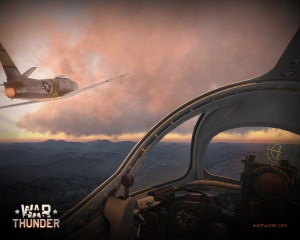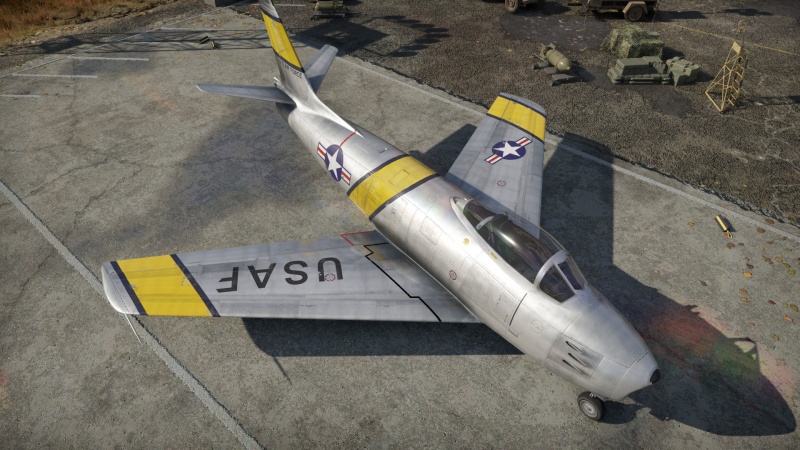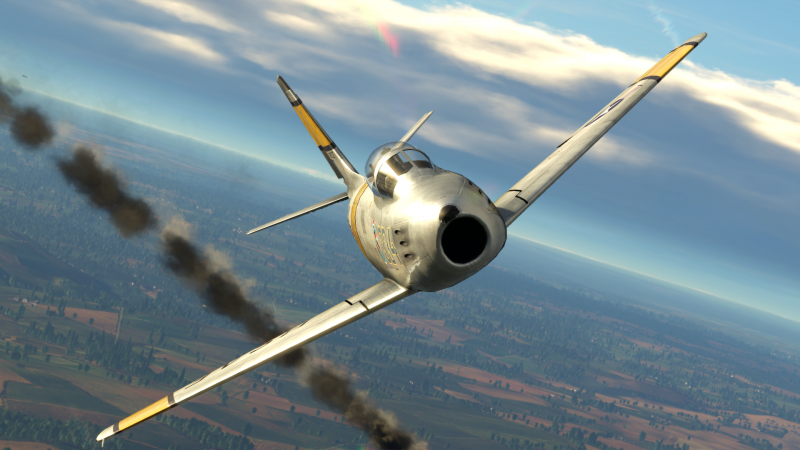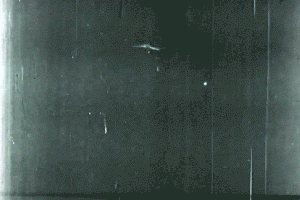F-86A-5
| This page is about the American jet fighter F-86A-5. For other versions, see F-86 (Family). |
Contents
Description
The F-86A-5, known as the P-86 before June 1948, was one of the most successful early jet aircraft. It featured swept wings which greatly reduced drag and increased the top speed to over 1,000 km/h (625 mph). In addition, the F-86A featured a ranging radar that could calculate the lead required for firing upon an enemy fighter; a big improvement over the Mark 18 optical computing sight that required manual adjustments before firing. Unfortunately, effectiveness was still hampered by the now weak .50 cal machine guns against jet aircraft which were typically almost all metal airframes. Nonetheless, the F-86 proved to be a very capable aircraft in the Korean War even if it was largely outdated by the late 1950s.
Introduced since the start of the Open Beta Test prior to 1.27, the F-86A-5 Sabre is a great jet for players entering more advanced jet combat. The Sabre features decent flight characteristics like a fast roll rate and is relatively nimble compared to contemporaries like the MiG-15. The Sabre does have six 12.7 mm machine guns all mounted in the nose which can be dangerous with the tracer belt (full API-T composition). However, players should expect many critical hits with these since they lack the outright stopping power of big cannon rounds. The F-86A-5’s J-47 engine is a also bit underpowered, and it takes time to reach sufficient speeds for combat so players should be wary of getting too slow. Overall, the F-86A-5 is a good plane for players to get used to the much faster speeds of later jets.
General info
Flight performance
The F-86A-5 like many of the first line variants of an aircraft promises the world but does not fully live up to the promise, which is accurate for the Sabrejet. Outfitted with the General Electric J47-GE-13 jet engine, the F-86A-5 struggles to climb to attack altitude and overall accelerate to sufficient attack speed. Its acceleration while taking off is very slow. However, once the F-86A-5 is at a good perching altitude, it can use its weight and manoeuvrability to Boom & Zoom other aircraft. This aircraft will not win many speed races against contemporary aircraft, however, with its speed, it can get in and out of a fight in a hurry and set up for another run. While the fighter is very agile when it comes to rolling, attempting to turn the aircraft results in a significant loss of speed. During this time, the wing's leading edge slats extend and help the fighter make tighter turns. However, sustained turns will bleed all of the fighter's energy, leaving it flying slow, an easy target for enemy aircraft.
One place where a slower F-86A-5 actually has an advantage is in the ground bombing role as the leading edge wing slats will help the manoeuvrability of the aircraft while lining up a bombing run with either 2,000 lbs of bombs or 16 HVAR rockets which can be unleashed from a stable weapons platform. When engaging ground targets, the trick is to get in and get out as quick as possible, because when flying low and slow, there is not much room for error and enemy fighters will be on the look out for aircraft on the deck without much room to manoeuvre. During bombing runs, reserve WEP power as a backup for departing the area. Once any external payload ordinances have been released, the F-86A-5 can resume its role as an interceptor.
| Characteristics | Max Speed (km/h at 0 m - sea level) |
Max altitude (metres) |
Turn time (seconds) |
Rate of climb (metres/second) |
Take-off run (metres) | |||
|---|---|---|---|---|---|---|---|---|
| AB | RB | AB | RB | AB | RB | |||
| Stock | 1,081 | 1,071 | 25.4 | 25.9 | 30.8 | 28.8 | 700 | |
| Upgraded | 1,105 | 1,093 | 22.7 | 24.0 | 46.2 | 38.1 | ||
Details
| Features | |||||
|---|---|---|---|---|---|
| Combat flaps | Take-off flaps | Landing flaps | Air brakes | Arrestor gear | Drogue chute |
| ✓ | ✓ | ✓ | ✓ | X | X |
| Limits | ||||||
|---|---|---|---|---|---|---|
| Wings (km/h) | Gear (km/h) | Flaps (km/h) | Max Static G | |||
| Combat | Take-off | Landing | + | - | ||
| 1,118 | 590 | 550 | 350 | ~11 | ~6 | |
| Optimal velocities (km/h) | |||
|---|---|---|---|
| Ailerons | Rudder | Elevators | Radiator |
| < 850 | < 600 | < 680 | N/A |
Engine performance
| Engine | Aircraft mass | ||||||
|---|---|---|---|---|---|---|---|
| Engine name | Number | Empty mass | Wing loading (full fuel) | ||||
| General Electric J47-GE-13 | 1 | 4,900 kg | 232 kg/m2 | ||||
| Engine characteristics | Mass with fuel (no weapons load) | Max Takeoff Weight | |||||
| Weight (each) | Type | 9m fuel | 20m fuel | 30m fuel | 31m fuel | ||
| 1,145 kg | Axial-flow turbojet | 5,285 kg | 5,740 kg | 6,154 kg | 6,196 kg | 9,530 kg | |
| Maximum engine thrust @ 0 m (RB / SB) | Thrust to weight ratio @ 0 m (100%) | ||||||
| Condition | 100% | WEP | 9m fuel | 20m fuel | 30m fuel | 31m fuel | MTOW |
| Stationary | 2,273 kgf | N/A | 0.43 | 0.40 | 0.37 | 0.37 | 0.24 |
| Optimal | 2,273 kgf (0 km/h) |
N/A | 0.43 | 0.40 | 0.37 | 0.37 | 0.24 |
Survivability and armour
- 38 mm Bulletproof glass - Front Windshield
- 6.35 mm Steel - Nose armour x 2
- 20 mm Steel - Pilot's headrest
- 12.7 mm Steel - Back of pilot's seat
Modifications and economy
Armaments
Offensive armament
The F-86A-5 is armed with:
- 6 x 12.7 mm M3 Browning machine guns, nose-mounted (300 rpg = 1,800 total)
Suspended armament
The F-86A-5 can be outfitted with the following ordnance:
- Without load
- 16 x HVAR rockets
- 2 x 1,000 lb AN-M65A1 Fin M129 bombs (2,000 lb total)
Usage in battles

The F-86A-5 should be played as a strict Boom & Zoom plane due to the fact that simple turns make it bleed a lot of speed. Gain some speed after takeoff (750-800 km/h or 466-500 mph) then zoom up to 3,000 m (9,800 ft) then turn to the centre after you're done zoom side-climbing. Next, you pick your targets. Dive, engage, zoom up smoothly (to not lose a lot of speed) then rinse and repeat. If there are multiple enemies above you, don't engage and keep flying straight. If there is one enemy above you in the vicinity, you can engage, but don't pull up hard or you will lose a lot of speed in the process! Do it smoothly. If you are generally low on speed and you can escape from enemies, keep flying straight until you're fast, zoom up then loop around and keep flying straight at the altitude you went up to then resume the strict Boom & Zoom procedure.
The F-86A-5 is not an air superiority fighter, it's more of a support plane despite being a Sabre. All top rank jets are a threat. All of them have better performance overall especially in acceleration, climb rate and energy retention.
For those who may have a F-86A-5 on their tail, if you're in an emergency (a situation where nothing that was explained works), resort to defensive flying. The defensive flying capabilities of the A-5 Sabre are very high and extremely good due to its roll rate. Most of the time, top rank jet pilots will Boom & Zoom you which can be a problem for you, however, if they decide to stick around and dogfight you, you will have the advantage.
Pros and cons
Pros:
- Very fast roll rate
- Leading-edge slats which improve low-speed manoeuvrability
- Nose-mounted weaponry with lots of ammunition
- Very agile with good dive and turn rates
- 12.7 mm .50 cal M3 Browning machine guns are effective weapons, with a high rate of fire & good damage output
- Can fly with one wing
Cons:
- Poor sustained climb rate
- Loses a lot of speed in turns
- Slow compared to its enemies
- Becomes sluggish when ordnance is equipped
- Very hard to get guns on target in horizontal due to weak rudder control
- May face supersonic aircraft with guided munitions
- High rate of fire makes ammunition deplete fast
History
The F-86 is considered one of the best fighter jets of the Korean War. It is the most-produced Western fighter, with almost 10,000 aircraft produced by the US, Australia, Canada (as the re-engined CL-13), Italy, and Japan.
The F-86 was developed by North American Aviation, the creator of the venerable P-51 Mustang. The XP-86 prototype was created to meet the USAF requirement for a high-altitude escort fighter. It was derived from the Navy's FJ-1 Fury, a transitional fighter jet that borrowed the wings, tail surfaces and canopy from the P-51D. The XP-86 was under threat of cancellation because the XP-80 and XP-84 had similar performance characteristics and were farther ahead in development. However, North American designers made a radical change to the design and replaced the straight wing with a swept wing, which was shown by seized German research to greatly reduce drag and increase performance at high speed. The resulting performance boost was so significant that the swept-wing prototype of the XP-86 was supposedly able to break the sound barrier in a dive a few days before Chuck Yeager made his official attempt.
The F-86A-5 is the first operational variant of the F-86. It is powered by the General Electric J47 engine and includes slats on the leading edge of the wing derived from the Messerschmitt Me 262 to increase low-speed performance. It is armed with six M3 .50 (12.7 mm) electrically boosted machine guns firing at 1,200 rounds per minute. It can carry eight 5" rockets, 2,000 lb of bombs, or a pair of external fuel tanks that can be jettisoned in-flight to increase performance in combat. While most of the F-86As had a Mark 18 manual ranging-computing gun sight, the last 24 F-86A-5-NAs were equipped with the A-1CM gun sight, which used radar to automatically compute a target's range. This later became standard on the F-86E.
| Archive of the in-game description | |
|---|---|
|
An all-metal monoplane jet fighter with swept wings. The development of the Sabre began in the autumn of 1944 as a modification of the NA-134 shipboard fighter. In November 1944, North-American presented its plan for a daytime fighter to the United States Army Air Forces (USAAF): the NA-140 model, based on the NA-134 and later given the designation of XP-86. It was decided in the design process that the XP-86 would feature the more promising swept wings instead of straight ones. The prototype Sabre XP-86, built with swept wings, first flew on October 1, 1947. The first production model of the Sabre was the P-86A (manufacturer number NA-151). In June 1948, the aircraft was given the new designation of F-86A. It was fitted with a General Electric J47-GE-1 (-3, -7) turbojet engine producing 2,360 kg of thrust. The aircraft's armament consisted of six 12.7 mm Browning M3 .50 cal machine guns with 1,800 total rounds of ammunition. The distinctive features of the production model were a curved windscreen and flaps over the machine gun firing ports, which could be closed by means of an electric motor. The first production P-86A-1 took off on 20 May 1948. Most of the F-86A-1s were used to perform various tests and were not delivered to the front. The F-86A-5 (NA-151) was the first real combat Sabre with a J47-GE-7 engine. It was produced for the first time on February 23, 1949. This model had a new windscreen, and the closeable flaps of the machine gun firing ports were removed to simplify maintenance. The cockpit canopy could be jettisoned if necessary. Two 780-litre fuel tanks could be mounted on the underwing pylons. Instead of fuel tanks, the aircraft could carry a combat load, which usually consisted of two 100 lb (45 kg), 500 lb (227 kg) or 1,000 lb (454 kg) bombs, two 375-kg tanks filled with napalm, or two 220 kg bomb clusters. Guide rails could also be mounted to hold eight unguided 5-inch HVAR rockets under each wing. A contract to deliver the next batch of the F-86As was signed in May 1948. These aircraft were still designated as F-86A-5s but they were named NA-161s at the plant, as they had a number of differences from previous series. In particular, they were equipped with a J47-GE-13 engine. Deliveries of this batch began in October 1949 and were finished in December of the following year. The last 24 F-86A-5s had a new A-1CM sight coupled with an AN/APG-30 radar ranging unit. The planes originally equipped with the A-1CM were designated as F-86A-6s, and those retrofitted on site were designated as F-86A-7s. The first USAAF military unit that received the F-86A was the 94th FS (Fighter Squadron) of the 1st FW (Fighter Wing). The pilots in the unit nicknamed the new fighter the Sabre. The F-86A fighters took part in the Korean War, making their first combat flight on December 17, 1950. Compared to its main opponent, the Mikoyan-Gurevich MiG-15 fighter, the Sabre's flight characteristics were somewhat better at low altitude, but it was inferior to the MiG in its rate of climbing, service ceiling, speed at high altitude, and armament. However, the Sabre's main advantage was its sight, equipped with a radar ranging unit that enabled more accurately aimed fire when manoeuvring at high speeds. The total number of the F-86A aircraft constructed was 554, and they served only with the USAF and the Air National Guard (ANG). | |
Notable pilots

Media
- Skins
- Videos
See also
- Related development
- Aircraft of comparable role, configuration and era
- Grumman F9F Cougar
- Lavochkin La-15
- Mikoyan-Gurevich MiG-15
- Mikoyan-Gurevich MiG-17
- Hawker Hunter
- Dassault Super Mystère
- Saab J29 Tunnan
External links
| North American Aviation | |
|---|---|
| Fighters | |
| P-51A | P-51 · P-51A |
| P-51C | P-51C-10 |
| P-51D | P-51D-5 · P-51D-10 · P-51D-20-NA · P-51D-30 |
| P-51H | P-51H-5-NA |
| Twin-engine fighters | F-82E |
| Jet fighters | F-86A-5 · F-86F-2 · F-86F-25 · F-86F-35 · F-100D |
| Strike aircraft | A-36 · PBJ-1H · PBJ-1J |
| FJ-4B · FJ-4B VMF-232 | |
| Bombers | B-25J-1 · B-25J-20 |
| Export/Licence | ▂B-25J-30 · ␗B-25J-30 |
| ▄Mustang Mk IA · F-6C-10-NA · ␗P-51C-11-NT · ␗P-51D-20 · J26 David · J26 · P-51D-20-NA · ␗P-51K | |
| F-86F-30 ▅ · ␗F-86F-30 · F-86F-40 ▅ · F-86F-40 JASDF▅ · ␗F-86F-40 | |
| ◄F-86K · ▄F-86K (Italy) · ▄F-86K (France) | |
| ␗F-100A · ▄F-100D · ␗F-100F | |
| Captured | ▅P-51C-11-NT |
| Canadair Limited license-built the F-86 as the CL-13 for use in Canada and export to Europe. | |
| Fiat license-built the F-86K for the Italian Air Force though another 120 NAA built F-86Ks were also sold to the Italians. | |
| See Also | Mitsubishi Heavy Industries · Canadair Limited · Fiat Aviation |
| USA jet aircraft | |
|---|---|
| Fighters | |
| F9F | F9F-2 · F9F-5 · F9F-8 |
| F-80 | F-80A-5 · F-80C-10 |
| F-84 | F-84B-26 · F-84F · F-84G-21-RE |
| F-86 | F-86A-5 · F-86F-25 · F-86F-2 · F-86F-35 |
| F-89 | F-89B · F-89D |
| F-100 | F-100D |
| F-104 | F-104A · F-104C |
| F-4 | F-4C Phantom II · F-4E Phantom II · F-4J Phantom II · F-4S Phantom II |
| F-5 | F-5A · F-5C · F-5E · F-20A |
| F-8 | F8U-2 · F-8E |
| F-14 | F-14A Early · ▄F-14A IRIAF · F-14B |
| F-15 | F-15A · F-15C MSIP II · F-15E |
| F-16 | F-16A · F-16A ADF · F-16C |
| Other | P-59A · F2H-2 · F3D-1 · F3H-2 · F4D-1 · F11F-1 |
| Strike Aircraft | |
| FJ-4 | FJ-4B · FJ-4B VMF-232 |
| A-4 | A-4B · A-4E Early |
| A-7 | A-7D · A-7E · A-7K |
| AV-8 | AV-8A · AV-8C · AV-8B Plus · AV-8B (NA) |
| A-10 | A-10A · A-10A Late · A-10C |
| F-111 | F-111A · F-111F |
| Other | A-6E TRAM · F-105D · F-117 |
| Bombers | |
| B-57 | B-57A · B-57B |







